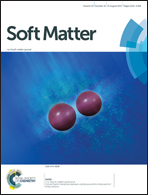Unexpected thermal annealing effects on the viscosity of polymer nanocomposites†
Abstract
The effects of thermal annealing, 12–50 K above the glass transition temperature, on the zero-shear viscosity, η, of polymer nanocomposites (PNCs) and the corresponding host polymers were studied. For all specimens, including neat and 4 wt% dioctyl phthalate (DOP)-plasticized polystyrene (PS), neat poly(methyl methacrylate) (PMMA), and PNCs containing bare and grafted silica nanoparticles in neat and DOP-plasticized PS, the η increased with time initially, and only asymptotically approached a steady-state value after thermal annealing for ∼100 to ∼200 h. We found that this phenomenon occurred regardless of the solvent used to prepare the sample although the fractional changes in η (δη/η) are visibly bigger for tetrahydrofuran (THF). Moreover, the PNCs not plasticized by DOP showed bigger δη/η than their host polymers while the plasticized ones behave essentially the same as the neat hosts. Interestingly, some unplasticized PNCs prepared from THF exhibited smaller viscosities than the host polymer, but this anomaly disappeared on thermal annealing. By correlating the viscosity measurements with the evolution of the solvent content, average NP aggregate size and the amount of adsorbed PS on silica for samples prepared from different solvents, we infer that the temporal viscosity evolution originates from out-of-equilibrium chain conformations produced during sample preparation. Because these relaxations are limited by the rearrangement of the polymer chains adsorbed on the NP or sample substrate surface, the timescales over which η changes can be much longer than the polymer reptation time, as observed.



 Please wait while we load your content...
Please wait while we load your content...